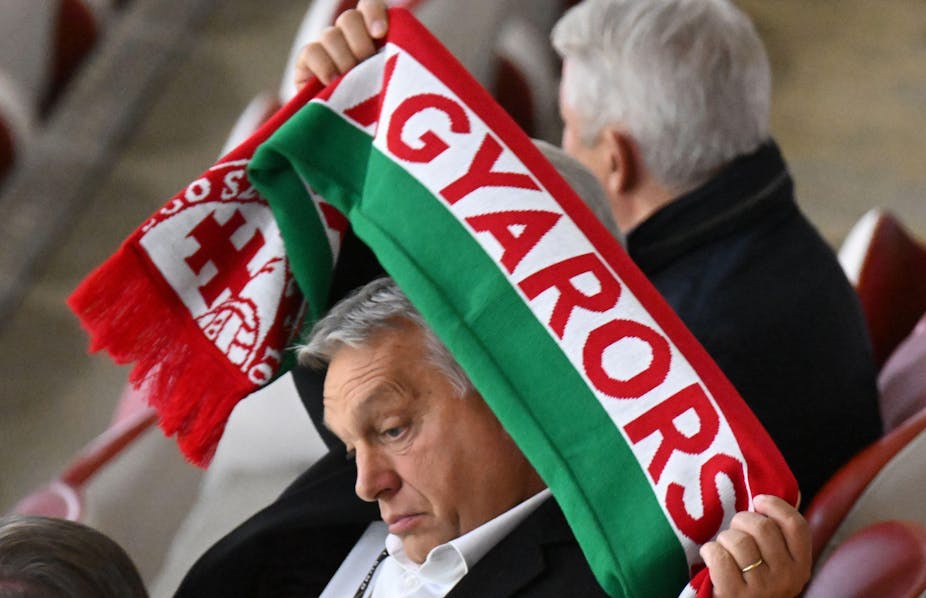A recent football match between Hungary and Greece – two countries that didn’t even qualify for the World Cup – would have been quickly forgotten were it not for the sartorial choices made by one of the spectators. Hungarian prime minister Viktor Orbán was in attendance, sporting a scarf with a provocative design that has triggered tensions with other world leaders.
The scarf depicted a map of Hungary but with the borders it had before the 1920 Treaty of Trianon, the peace agreement that ended the first world war. As part of this agreement, Hungary ceded land to neighbours Austria, Croatia, Romania, Serbia, Slovakia and Ukraine.
In modern times, the image of Hungary with its pre-Trianon borders intact has been mobilised by right-wing Hungarian nationalists and named “Greater Hungary”. Subscribers to this “irredentist” ideology (advocating restoration of territory) believe Hungary should reclaim the land it feels was wrongfully taken via Trianon.
Understandably, given this history, Orbán’s scarf was swiftly condemned by Romania, Slovakia, and Ukraine.
An old trick
This is not the first time Orbán has courted the controversial idea of Greater Hungary. Since his ascent to power in 1998, the idea of revisiting the Trianon settlement to reclaim lost territory has been a feature of his politics. During and after his first period in power between 1998 and 2006, Orbán frequently antagonised neighbouring governments with calls for a cultural and social reunification between Hungary and its diaspora communities.
When he was re-elected to power in 2010, criticising Trianon became an even more important tactic for Orbán. In 2011 he passed a law that made it possible for all Hungarian-speaking descendants of citizens from the country’s pre-Trianon borders to claim Hungarian citizenship. A national unity day was also introduced to commemorate Hungary’s territorial losses at Trianon.
The idea for such a day did not originate with Orbán or his party Fidesz, but rather with Jobbik, their far-right competitors. Taking this policy from Jobbik’s 2010 manifesto was part of a broader Fidesz strategy to become Hungary’s dominant right-wing party on key policy issues.
Invoking the idea of Greater Hungary is therefore no longer a fringe tactic. Earlier this year, Hungarian government spokesperson Zoltan Kovács was pictured with a giant map of Greater Hungary in his office. The idea of restoring Greater Hungary is now a part of mainstream political life.
Drawing attention to himself through irredentist posturing – such as wearing a Greater Hungary scarf – often serves Orbán’s domestic interests. The criticism he receives on the international stage plays into Orbán’s self-styled image as a “tragic” figure fighting to rectify the “injustices” of Trianon. Such a trope has been used repeatedly to delegitimise criticisms the Orbán governmnet. According to the prime minister, these are attacks not on him but the Hungarian nation.
Orbán’s irredentism also has international implications even if it largely amounts to hot air. One of his 2014 speeches included a call for ethnic Hungarians in Ukraine to be given dual citizenship and “the opportunity for autonomy”. This followed Russia’s illegal annexation of Crimea and invasion of eastern Ukraine and was potentially a reference to the controversial referendums there organised by Russia.
Orban also advocated similar concessions for Hungarians throughout the Carpathian Basin, a region including parts of Croatia, Serbia and Slovakia. The claims were swiftly rejected by Ukraine and were largely ignored by everyone else.
Why it matters
Orbán has taken no meaningful action to re-expand Hungary’s borders so his rhetoric should not be taken too seriously in the most literal sense. But that does not mean there are no consequences, especially at a time of heightened tensions in Europe.
This has become clear during Russia’s invasion of Ukraine, itself launched on irredentist claims. Not only has Orbán sported irredentist iconography as the invasion continues, he has threatened to veto EU attempts to send aid to the Ukraine war effort. Apart from offending Ukraine, Orbán’s actions have undermined a united European effort to condemn and bring the war to an end.
Consequently, Hungary has become increasingly isolated from Europe, facing criticism from the EU and one of the country’s closest allies, Poland. Hungary and Poland have formed something of an alliance in recent years, having both disagreed with Brussels over their approach to the democratic principles that are supposed to define European member states.
However, Poland has been one of Russia’s most vocal critics since the invasion while Hungary has (at the very least) implied its allegiance lies with the Kremlin. Poland is now joining others in pressuring Hungary to accept Nato expansion, a sign their mutual support is beginning to crumble.
Orbán has become used to being able to casually throw irredentist iconography around for domestic political gain without consequences. It can be seen as a symbol of his willingness to upset the established order of things in Europe.
Now, however, wider geographical tensions bring new meaning to his manoeuvres, which explains his neighbours’ frustration. The prevailing European geopolitical climate does not allow for such game playing. Orbán may find it more politically expedient to leave his scarf at home for the next match.

